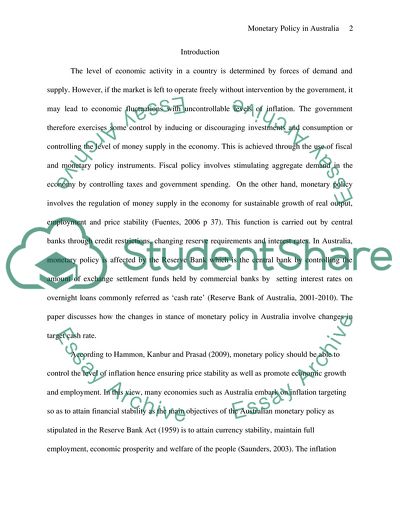Cite this document
(Monetary Policy in Australia Report Example | Topics and Well Written Essays - 1500 words, n.d.)
Monetary Policy in Australia Report Example | Topics and Well Written Essays - 1500 words. https://studentshare.org/macro-microeconomics/1742466-monetary-policy-influences-interest-rates-which-in-turn-affect-the-level-of-aggregate-demand-discuss-how-changes-in-the-stance-of-monetary-policy-in-australia-involve-changes-in-the-target-cash-rate
Monetary Policy in Australia Report Example | Topics and Well Written Essays - 1500 words. https://studentshare.org/macro-microeconomics/1742466-monetary-policy-influences-interest-rates-which-in-turn-affect-the-level-of-aggregate-demand-discuss-how-changes-in-the-stance-of-monetary-policy-in-australia-involve-changes-in-the-target-cash-rate
(Monetary Policy in Australia Report Example | Topics and Well Written Essays - 1500 Words)
Monetary Policy in Australia Report Example | Topics and Well Written Essays - 1500 Words. https://studentshare.org/macro-microeconomics/1742466-monetary-policy-influences-interest-rates-which-in-turn-affect-the-level-of-aggregate-demand-discuss-how-changes-in-the-stance-of-monetary-policy-in-australia-involve-changes-in-the-target-cash-rate.
Monetary Policy in Australia Report Example | Topics and Well Written Essays - 1500 Words. https://studentshare.org/macro-microeconomics/1742466-monetary-policy-influences-interest-rates-which-in-turn-affect-the-level-of-aggregate-demand-discuss-how-changes-in-the-stance-of-monetary-policy-in-australia-involve-changes-in-the-target-cash-rate.
“Monetary Policy in Australia Report Example | Topics and Well Written Essays - 1500 Words”. https://studentshare.org/macro-microeconomics/1742466-monetary-policy-influences-interest-rates-which-in-turn-affect-the-level-of-aggregate-demand-discuss-how-changes-in-the-stance-of-monetary-policy-in-australia-involve-changes-in-the-target-cash-rate.


